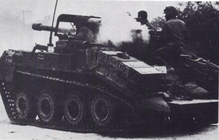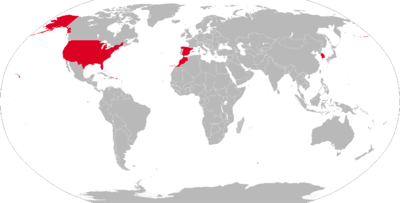M56 Scorpion
The M56 Scorpion is an American unarmored, airmobile self-propelled anti-tank gun, which was armed with a 90mm M54 gun with a simple blast shield, and an unprotected crew compartment.
| M56 Scorpion | |
|---|---|
M56 Scorpion preserved at the American Armored Foundation Tank Museum in Danville, Virginia. | |
| Type | Self-propelled gun |
| Place of origin | United States |
| Service history | |
| Used by | See Operators |
| Wars | Vietnam War Western Sahara War |
| Production history | |
| Manufacturer | Cadillac Motor Car Division of General Motors |
| Produced | 1953–1959 |
| No. built | 325 |
| Specifications | |
| Mass | 7.1 tonnes (16,000 lb) |
| Length | 4.55 metres (14 ft 11 in) (excluding gun) 5.84 metres (19 ft 2 in) (overall) |
| Width | 2.57 metres (8 ft 5 in) |
| Height | 2.05 metres (6 ft 9 in) over gun shield |
| Crew | 4 (commander, gunner, loader and driver) |
| Armor | unarmored except for blast shield |
Main armament | 90 mm M54 Gun 29 rounds |
| Engine | Continental A01-403-5 gasoline engine 200 brake horsepower (150 kW) |
| Transmission | Allison CD-150-4, 2 ranges forward, 1 reverse |
| Suspension | Torsion tube over bar at wheels 1 and 4, torsion bar at wheels 2 and 3 |
| Ground clearance | 0.32 m (1 ft 1 in) |
| Fuel capacity | 210 litres (46 imp gal; 55 US gal) |
Operational range | 230 kilometres (140 mi) |
| Maximum speed | 45 kilometres per hour (28 mph) |
History
The M56 was manufactured from 1953 to 1959 by the Cadillac Motor Car Division of General Motors for use by US airborne forces, though the vehicle was eventually used by the Spanish Navy Marines, Morocco and the Republic of Korea as well. With a crew of four (commander, gunner, loader and driver), the M56 weighed 6.4 tonnes (14,000 lb) empty and 7.7 tonnes (17,000 lb) combat-loaded. It had infrared driving lights but no Nuclear, Biological and Chemical (NBC) protection system and was not amphibious.
The M56 was a fully tracked vehicle with rubber-tired run-flat road wheels and front drive sprocket wheels. It was powered by a Continental A01-403-5 gasoline engine developing 200 brake horsepower (150 kW) at 3,000 rpm, allowing a maximum road speed of 28 miles per hour (45 km/h) and a maximum range of 140 miles (230 km). Twenty-nine rounds of main gun ammunition were carried, and only the small 5mm thick blast shield was armored.
In service

The M56 saw combat service with U.S. forces in the Vietnam War. It was deployed with the 173rd Airborne Brigade, which was the only Airborne Brigade deployed with the M56,[1] where it was used mainly in a direct fire-support role. Its function as an air-mobile, self-propelled, anti-tank vehicle was eventually replaced in Vietnam by the troubled but effective M551 Sheridan which had a fully armored turret. The USMC used the Ontos, which had an armored cabin and was armed with recoilless rifles, in a similar role (the running gear of the first Ontos prototype was the same as on the M56, but it was replaced for the production variant).
As for foreign operators, Morocco was only export customer which had used M56 Scorpions in actual combat. M56 Scorpions were deployed against Polisario rebels during Western Sahara War.
Operators

Former operators





Survivors

United States
- American Legion Post 8 in Guntersville, Alabama.
- Two of them can be found in the American Military Museum in South El Monte, California.
- American Legion post in Duluth, Georgia.
- Ropkey Armor Museum in Crawfordsville, Indiana
- Veterans Memorial Stadium in Cedar Rapids, Iowa.
- Iowa Gold Star Museum at Camp Dodge in Johnston, Iowa.
- Combat Air Museum at the former Forbes Field, in Topeka, Kansas.
- Forest Hill Station in Millersburg, Kentucky.
- Boyd County War Memorial in Armco Park in Summit, Kentucky.
- One can be found in Constitution Park in Cumberland, Maryland.
- Military Vehicle Technology Foundation's facility in Portola Valley, in California. However, it will soon be relocated to the Collings Foundation in Stow, Massachusetts.
- Elmwood Park, New Jersey.
- 82nd Airborne War Memorial Museum in Fort Bragg, North Carolina.
- Fort Sill, Oklahoma
- 45th Infantry Museum in Oklahoma City, Oklahoma.
- One can be found in the city of Elkton, South Dakota on the corner of Elk St. and 3rd St.
- American Legion Hall, Post 88, in Donelson, Tennessee.
- Texas Military Forces Museum, Camp Mabry in Austin, Texas.
- Veterans of Foreign Wars Post 2524 Culpepper, Virginia.
- A restored M56 is on display at the American Armored Foundation Tank Museum in Danville, Virginia, along with a diorama of a destroyed M56.
- A well preserved M56 can be found in a city park in Auburn, Washington.
- Tillicum Park in Forks, Washington.
South Korea
- One former Republic of Korea Army example on display at the War Memorial of Korea.
See also
- G-numbers (SNL G289)
- M-numbers
- FV4401 Contentious
References
- Notes
- Rottman, Gordon L.; Anderson, Duncan (22 April 2008). The US Army in the Vietnam War 1965-73. Bloomsbury USA. ISBN 9781846032394 – via Google Books.
- Estes 2016, p. 44.
- Estes 2016, p. 46.
- Bibliography
- Foss, Christopher F. (1974) [1972]. Jane's Pocket Book of Tanks and Armored Fighting Vehicles. Collier Books. p. 153. LC Control No. 73-15286.
- Trewhitt, Philip (1999). Armored Fighting Vehicles. New York, NY: Amber Books. p. 126. ISBN 0-7607-1260-3.
- Estes, Kenneth W (2016). M50 Ontos and M56 Scorpion 1956–70: US Tank Destroyers of the Vietnam War. New Vanguard 240. Osprey Publishing. ISBN 9781472814739.CS1 maint: ref=harv (link)
External links
| Wikimedia Commons has media related to M56 Scorpion. |